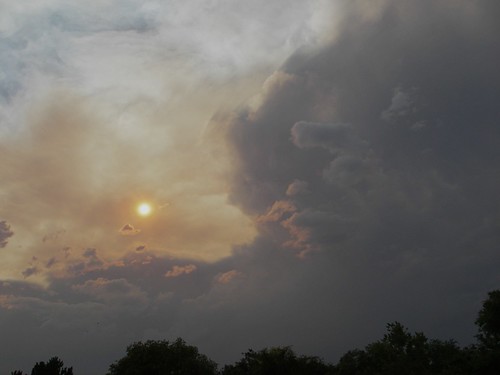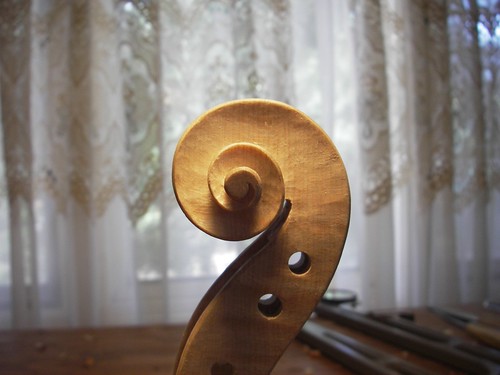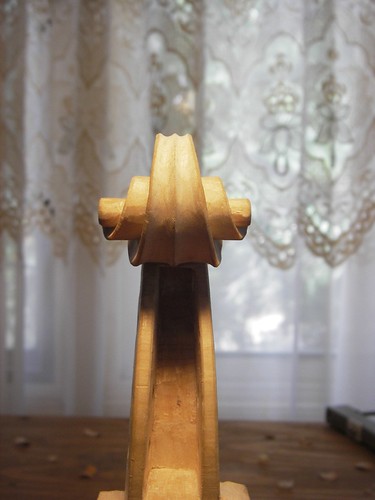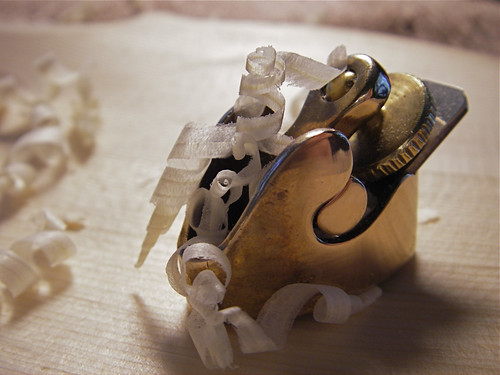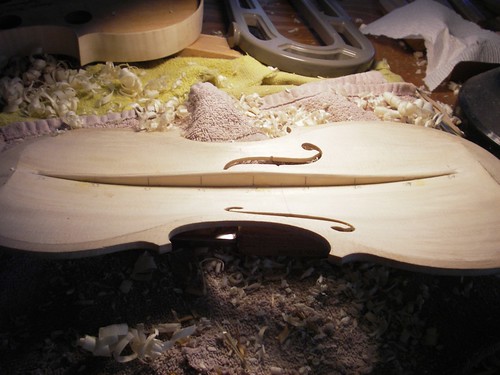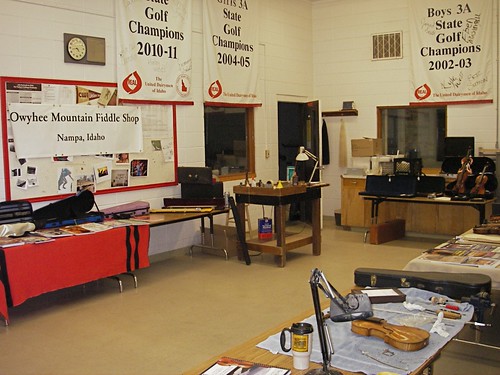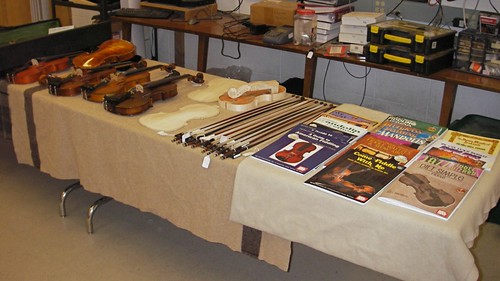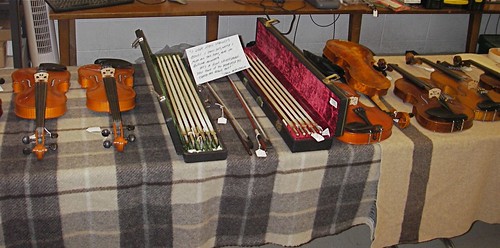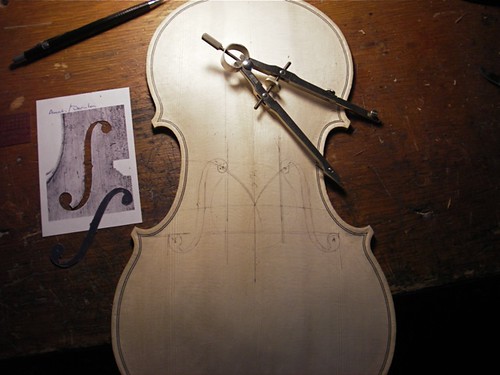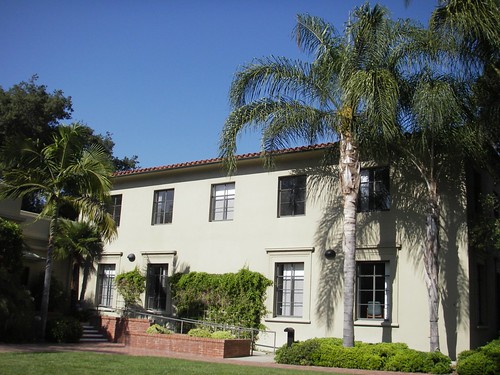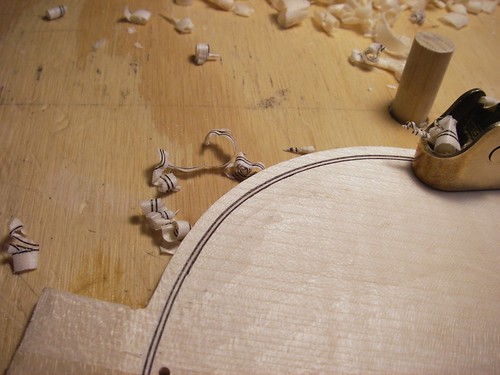With all the pieces finished, it's a matter to put them together. Glueing the plates to the rib assembly (after it's been removed from the form) is fairly straight-forward. You need to be a little careful to get the overhangs reasonably uniform, and to clean up any glue that gets onto wood that will later be varnished. Setting the neck is challenging -- lots of angles to get right, nothing flat to measure against, and you can't see it all until you get it where you want it.
But, we trudge onward --
To give the wood a little character, we expose it to UV. Nowadays, most builders seem to have nice UV boxes, and I want to build one, but right now I just do it the old way -- sunlight.
We're hot these days -- 6th day in a row at 100 degrees F or over, and the skies are a bit thick with smoke from surrounding wildfires. Here's a shot of the sky a couple evenings ago, with both thunderstorm clouds and smoke.
Of course, if I get even a hint of a thunderstorm, or even wind, I bring the fiddle indoors. Not interested in that sort of antiquing!
Thursday, July 12, 2012
Friday, July 6, 2012
Scroll carving.
The violin scroll is that one recognizable part that everyone knows, except maybe beginning violin-makers such as myself. What does it look like anyway? To the general public, they all look the same. To experienced violin-folk, they're individual. Guarneri del Gesu's loopy asymmetric scrolls seem charming in a way the rest of us can only envy. The near perfection of Stradivari or the Amati are something we can strive for. In the meantime, those of us toiling with the scroll -- which has really no impact on the sound of the fiddle -- cut one, look at it, learn something, and resolve to do better next time.
Here's a side view of my current project, with shadows -- helps to bring out the tool marks, some of which I'll get out of the way, others I'll not see until too late or ignore because they don't bother me. Right now, there are still plenty that bother me, but I'll look at them another day.
Here's a more conventional view.
Not completely finished, but I can straighten up some of the lines tomorrow.
A non-typical view point for most folks, but for violin makers, you end up looking at the darn thing from all sorts of angles.
So, I'm not completely happy with it, but on the other hand, it will be ok, and now I can concentrate on the neck and fingerboard, which really is important to the player. Surprisingly, or perhaps not, but the neck is crucial. It's the one place on the fiddle that the player's hand comes in contact with the fiddle, and has a tremendous influence on the way a player views an instrument.
But visually, more people consider the scroll. Oh well...
Here's a side view of my current project, with shadows -- helps to bring out the tool marks, some of which I'll get out of the way, others I'll not see until too late or ignore because they don't bother me. Right now, there are still plenty that bother me, but I'll look at them another day.
Here's a more conventional view.
Not completely finished, but I can straighten up some of the lines tomorrow.
A non-typical view point for most folks, but for violin makers, you end up looking at the darn thing from all sorts of angles.
So, I'm not completely happy with it, but on the other hand, it will be ok, and now I can concentrate on the neck and fingerboard, which really is important to the player. Surprisingly, or perhaps not, but the neck is crucial. It's the one place on the fiddle that the player's hand comes in contact with the fiddle, and has a tremendous influence on the way a player views an instrument.
But visually, more people consider the scroll. Oh well...
Thursday, July 5, 2012
Glueing the top to the ribs
Getting ready to remove the form from the ribs, I clip the blocks with a chisel and mallet. This gives me a little more wiggle room.
The rib assembly is flexible yet strong. It only takes a few minutes to get the form out. I clean up the blocks most of the way before glueing the top on.
Hide glue and clamps, we starting to have a box. Always a fun point in the process. I spent some time carving the scroll today as well, and it is sitting in the background between the sharpening stone and the caliper.
Now a glass of wine is in order.
Wednesday, July 4, 2012
Finishing the inside of the top
With the outside pretty much done, it's time to finish the inside of the top. I use a big-sweep gouge to remove most of the stuff, and this goes fairly fast. Then onto thumb-planes of decreasing size. At the end, you're removing fairly thin shavings. This thumbplane has a sole length of 28-mm, or about an inch and an eighth.
I use a graduation-punch modeled after the one in the Stradivari Museum in Cremona to mark the final thicknesses. Here, the punch is a 16d nail sharpened on a grinder and the anvil is a carriage bolt with a wing-nut soldered on to allow up and down adjustment. You simply put the plate in the center, against the anvil, and lower the upper arm to press holes to the proper depth.
As we get thinner, we can use light to look for uneveness.
It's a little-known fact that Stradivari invented the incandescent lightbulb for this very purpose. At least, that's what I've heard from some violinmakers, but further research has shed some doubt an that attribution. At the very least, bright light is a good tool on new wood. The two dark bands here are stripes of denser wood showing up more and more prominently as I proceed. Wood -- you never know exactly what to expect.
When the inside is finished, the bass-bar material is then fit to the surface. Once the fit is done, it is glued in place with hide glue. Here I am using simple, old-fashioned clamps to hold the bass bar in place.
After the glue has set, the bassbar profile can be shaped.
With that, the insides are done. Next is to shape the edges, then glue the top onto the rib assembly.
I use a graduation-punch modeled after the one in the Stradivari Museum in Cremona to mark the final thicknesses. Here, the punch is a 16d nail sharpened on a grinder and the anvil is a carriage bolt with a wing-nut soldered on to allow up and down adjustment. You simply put the plate in the center, against the anvil, and lower the upper arm to press holes to the proper depth.
As we get thinner, we can use light to look for uneveness.
It's a little-known fact that Stradivari invented the incandescent lightbulb for this very purpose. At least, that's what I've heard from some violinmakers, but further research has shed some doubt an that attribution. At the very least, bright light is a good tool on new wood. The two dark bands here are stripes of denser wood showing up more and more prominently as I proceed. Wood -- you never know exactly what to expect.
When the inside is finished, the bass-bar material is then fit to the surface. Once the fit is done, it is glued in place with hide glue. Here I am using simple, old-fashioned clamps to hold the bass bar in place.
After the glue has set, the bassbar profile can be shaped.
With that, the insides are done. Next is to shape the edges, then glue the top onto the rib assembly.
Monday, July 2, 2012
Weiser 2012
The National Old-Time Fiddlers Contest has been held during the third full-week in June for many years now. This year was its 60th anniversary (the same as celebrated by the Queen of England), though I don't know that it's been the third-full week in June all that time. It has since before I've been going. Went to my first Weiser in 1995.
Phil Stanley, a Boise bowmaker, and I have been running the repair shop for maybe 10 years now. We're not sure, and would have to look through our records to figure it out -- clearly not important enough for us to actually do it. We started out the first couple years running it under Hartz Music's sign, but since then on our own hook.
We set up behind the practice area in the Weiser High School. Here's the view as you come in the door.
As you can see, visually its a mixture of high-school sports, woodshop, computer shop, and our violin and bow shop. I have a place here in the foreground to do violin repairs, while Phil sets up at the back bench where he does bow rehairs and repairs.
We sell books, cases, bows, fiddles, some strings and tuners.
Phil tries to sell his handmade bows, and I try to sell my fiddles, both factory and handmade.
We've been there long enough that we have a good time seeing the same faces year after year, as well as seeing what were little kids becoming young adults.
Phil Stanley, a Boise bowmaker, and I have been running the repair shop for maybe 10 years now. We're not sure, and would have to look through our records to figure it out -- clearly not important enough for us to actually do it. We started out the first couple years running it under Hartz Music's sign, but since then on our own hook.
We set up behind the practice area in the Weiser High School. Here's the view as you come in the door.
As you can see, visually its a mixture of high-school sports, woodshop, computer shop, and our violin and bow shop. I have a place here in the foreground to do violin repairs, while Phil sets up at the back bench where he does bow rehairs and repairs.
We sell books, cases, bows, fiddles, some strings and tuners.
Phil tries to sell his handmade bows, and I try to sell my fiddles, both factory and handmade.
We've been there long enough that we have a good time seeing the same faces year after year, as well as seeing what were little kids becoming young adults.
Friday, June 29, 2012
Laying out and cutting f-holes
Using a few straight lines -- down the center, across the stop length (where the bridge will sit), and across at the low point of the c-bout purfling -- and circles of 32- and 64-mm, I'm trying to make the f-holes look right.
I'm using the lay-out scheme featured on Michael Darnton's website, as well as an image of a Brothers Amati f-hole he likes. Even with all that, I still end up adjusting it a bit by eye. And in doing so, hope to train my eye in the long-run. Finally, say 'good enough' and cut the holes.
At this point they've got something of the shape, but still a little too thin. How to decide that? I make them wide enough to get the soundpost through. I'm sure there must be a better criterion, but that works for now.
After a bit of clean-up work, I think I have them ok.
The poster below is of a 1666 Nicolo Amati, son of one of the Brothers Amati, and what I used as a model for my eye. Again, not a perfect copy by any means, but something I hope works and looks decent.
I'm using the lay-out scheme featured on Michael Darnton's website, as well as an image of a Brothers Amati f-hole he likes. Even with all that, I still end up adjusting it a bit by eye. And in doing so, hope to train my eye in the long-run. Finally, say 'good enough' and cut the holes.
At this point they've got something of the shape, but still a little too thin. How to decide that? I make them wide enough to get the soundpost through. I'm sure there must be a better criterion, but that works for now.
After a bit of clean-up work, I think I have them ok.
The poster below is of a 1666 Nicolo Amati, son of one of the Brothers Amati, and what I used as a model for my eye. Again, not a perfect copy by any means, but something I hope works and looks decent.
Sunday, June 24, 2012
Southern California Violin Makers Workshop 2012
June is typically a busy month for me. Since 2008, I have been attending the Southern California Violin Makers Workshop for a week, sometimes 2, and then during the third full-week in June, we have the shop set up at the National Old-time Fiddlers Contest in Weiser, Idaho.
So today I'll post about the workshop. It's held in Claremont, California, put on by Jim Brown, and taught/led by Michael Darnton of Chicago. The grounds are not too bad.
The violin-makers workshop was held on the ground-floor in this wing of the building --
while the bow-makers were across the way in this wing, behind the arched walkway --
Most of the attendees had been to the workshop before, and all (in the first two weeks) had built previous violins. Everyone was at a different place in their current violin and the atmosphere is such that we can ask questions about anything at any time. We all just set down at a bench and start working. Seeing what other people are doing, how they're doing it, the tools they're using are all wonderful ways of learning.
For me the greatest thing is that I learn so much I didn't even know to ask about.
One of my goals this time was to learn more about the outline and corners. I believe I made a major conceptual breakthrough in my understanding of corner geometry. I was never happy with the shape of my violin corners, mainly because I didn't have a clear picture in my head. Now, after years of having it presented to me, something finally clicked. It's now a matter of execution.
Towards the end of my week there, I got the purfling in both plates of my Brothers Amati fiddle.
And I spent some time working the edges down.
The workshop's official site is here. If I understand it correctly, the workshop is accepting beginners during the third week.
I have more photos of the workshop here.
Michael Darnton's website is here.
So today I'll post about the workshop. It's held in Claremont, California, put on by Jim Brown, and taught/led by Michael Darnton of Chicago. The grounds are not too bad.
The violin-makers workshop was held on the ground-floor in this wing of the building --
while the bow-makers were across the way in this wing, behind the arched walkway --
For me the greatest thing is that I learn so much I didn't even know to ask about.
One of my goals this time was to learn more about the outline and corners. I believe I made a major conceptual breakthrough in my understanding of corner geometry. I was never happy with the shape of my violin corners, mainly because I didn't have a clear picture in my head. Now, after years of having it presented to me, something finally clicked. It's now a matter of execution.
Towards the end of my week there, I got the purfling in both plates of my Brothers Amati fiddle.
And I spent some time working the edges down.
The workshop's official site is here. If I understand it correctly, the workshop is accepting beginners during the third week.
I have more photos of the workshop here.
Michael Darnton's website is here.
Subscribe to:
Posts (Atom)




